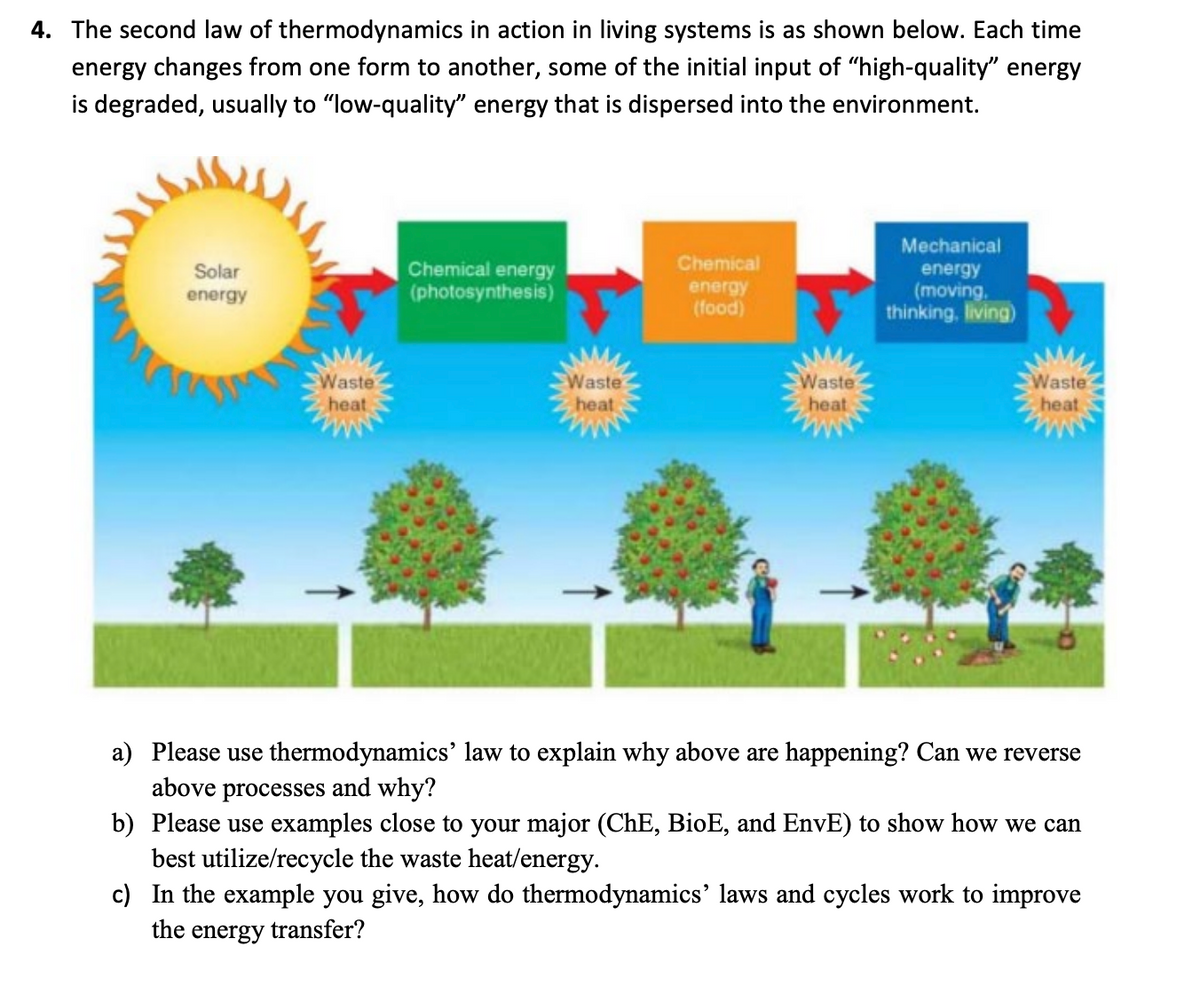4. The second law of thermodynamics in action in living systems is as shown below. Each time energy changes from one form to another, some of the initial input of "high-quality" energy is degraded, usually to "low-quality" energy that is dispersed into the environment. Solar energy Waste heat Chemical energy (photosynthesis) Waste heat Chemical energy (food) Waste heat Mechanical energy (moving thinking, living) Waste heat a) Please use thermodynamics' law to explain why above are happening? Can we reverse above processes and why? b) Please use examples close to your major (ChE, BioE, and EnvE) to show how we can best utilize/recycle the waste heat/energy. c) In the example you give, how do thermodynamics' laws and cycles work to improve the energy transfer?
4. The second law of thermodynamics in action in living systems is as shown below. Each time energy changes from one form to another, some of the initial input of "high-quality" energy is degraded, usually to "low-quality" energy that is dispersed into the environment. Solar energy Waste heat Chemical energy (photosynthesis) Waste heat Chemical energy (food) Waste heat Mechanical energy (moving thinking, living) Waste heat a) Please use thermodynamics' law to explain why above are happening? Can we reverse above processes and why? b) Please use examples close to your major (ChE, BioE, and EnvE) to show how we can best utilize/recycle the waste heat/energy. c) In the example you give, how do thermodynamics' laws and cycles work to improve the energy transfer?
Introduction to Chemical Engineering Thermodynamics
8th Edition
ISBN:9781259696527
Author:J.M. Smith Termodinamica en ingenieria quimica, Hendrick C Van Ness, Michael Abbott, Mark Swihart
Publisher:J.M. Smith Termodinamica en ingenieria quimica, Hendrick C Van Ness, Michael Abbott, Mark Swihart
Chapter1: Introduction
Section: Chapter Questions
Problem 1.1P
Related questions
Question
100%
Simple 1 sentence answers only needed. For part B please tell how it could be used to help the environment.

Transcribed Image Text:4. The second law of thermodynamics in action in living systems is as shown below. Each time
energy changes from one form to another, some of the initial input of "high-quality" energy
is degraded, usually to "low-quality" energy that is dispersed into the environment.
Solar
energy
Waste
heat
Chemical energy
(photosynthesis)
Waste
heat
Chemical
energy
(food)
Waste
heat
Mechanical
energy
(moving
thinking, living)
Waste
heat
a) Please use thermodynamics' law to explain why above are happening? Can we reverse
above processes and why?
b) Please use examples close to your major (ChE, BioE, and EnvE) to show how we can
best utilize/recycle the waste heat/energy.
c) In the example you give, how do thermodynamics' laws and cycles work to improve
the energy transfer?
Expert Solution
This question has been solved!
Explore an expertly crafted, step-by-step solution for a thorough understanding of key concepts.
This is a popular solution!
Trending now
This is a popular solution!
Step by step
Solved in 3 steps

Recommended textbooks for you

Introduction to Chemical Engineering Thermodynami…
Chemical Engineering
ISBN:
9781259696527
Author:
J.M. Smith Termodinamica en ingenieria quimica, Hendrick C Van Ness, Michael Abbott, Mark Swihart
Publisher:
McGraw-Hill Education

Elementary Principles of Chemical Processes, Bind…
Chemical Engineering
ISBN:
9781118431221
Author:
Richard M. Felder, Ronald W. Rousseau, Lisa G. Bullard
Publisher:
WILEY

Elements of Chemical Reaction Engineering (5th Ed…
Chemical Engineering
ISBN:
9780133887518
Author:
H. Scott Fogler
Publisher:
Prentice Hall

Introduction to Chemical Engineering Thermodynami…
Chemical Engineering
ISBN:
9781259696527
Author:
J.M. Smith Termodinamica en ingenieria quimica, Hendrick C Van Ness, Michael Abbott, Mark Swihart
Publisher:
McGraw-Hill Education

Elementary Principles of Chemical Processes, Bind…
Chemical Engineering
ISBN:
9781118431221
Author:
Richard M. Felder, Ronald W. Rousseau, Lisa G. Bullard
Publisher:
WILEY

Elements of Chemical Reaction Engineering (5th Ed…
Chemical Engineering
ISBN:
9780133887518
Author:
H. Scott Fogler
Publisher:
Prentice Hall


Industrial Plastics: Theory and Applications
Chemical Engineering
ISBN:
9781285061238
Author:
Lokensgard, Erik
Publisher:
Delmar Cengage Learning

Unit Operations of Chemical Engineering
Chemical Engineering
ISBN:
9780072848236
Author:
Warren McCabe, Julian C. Smith, Peter Harriott
Publisher:
McGraw-Hill Companies, The